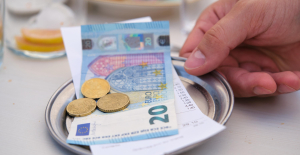Knickerbockers, knee-high socks, wide suspenders, small-check peaked cap – this is how Hendrik Seiffert greets the guests on his city tour. It's the 1920s look. Seiffert follows in the footsteps of Fritz Haarmann, one of the most famous serial killers in German criminal history.
Haarmann committed at least 24 murders, mostly in 1923 and 1924. In principle, he was "the German Jack the Ripper," according to Seiffert. Last but not least, the memory of Haarmann is kept alive by a modified, macabre operetta chorus that says: "Wait, just wait a while, Haarmann will come to you soon, with the little cleaver, he'll make minced meat out of you."
"We will go to all the criminal hotspots of the 1920s," says Seiffert. This includes the main train station, where the tour starts. Haarmann would have worked here as a “police spy” and “met most of his victims,” says Seiffert. Without exception, these were male and between 10 and 22 years old.
These were often outliers whose disappearance hardly surprised anyone. Haarmann invited her to his home, promising lodging and food.
The second station, the Kröpcke, a central point in the middle of Hanover, was also considered a criminal hotspot. In the years after the First World War, male minors also prostituted themselves here. "Kriminal-Haarmann", as he was called there because of his work as a spy, stopped by frequently. You knew each other.
Photos that Seiffert brought with him show just how much Hanover has changed since then. The Ballhof, today a cozy place with a theatre, tea room, beer bar and restaurant, used to be a small alley and meeting place for the homosexual scene. The flourishing life of liberal Hanover pulsated here, and Hans Grans, Haarmann's assistant and temporary lover, also lived here.
From the Ballhof it is only a few steps to the leash. At that time the river still had two branches. These enclosed "Little Venice", an island densely built up with half-timbered houses in which poor people lived, because, according to Seiffert, living space was scarce.
The series of murders was first reported on the Leine-Ufer in the spring of 1924 – children found bones and skulls. Before that there were only rumours.
Seiffert leads his guests over a river bridge to the Rote Reihe, a street in Calenberger Neustadt. Haarmann moved into an attic room here in 1923.
The house is no longer there, but Seiffert holds up a photo. It shows a room with a bed, chair, table and washbasin, little more. It was in this apartment that Haarmann killed most of his victims, saying he bit their throats. Then Haarmann went to sleep. He later dismembered the body and brought the bones in a suitcase on a leash.
Seiffert, who studies politics and geography and offers the tours as a part-time job, describes all of this rather soberly. He doesn't want to cater to the voyeurism that he observes in connection with crime city tours, says Seiffert. "I'm too scientific, it's more my nature."
Fritz Haarmann was arrested in June 1924. At first only because he had gotten into an argument with a young man. When police searched his home, they found evidence of the crime. The more than rude interrogation methods finally led to a confession. The court found him guilty of 24 counts of murder and imposed the death penalty.
The executioner's meal is said to have consisted of ham bread and Harz cheese - a wish from Haarmann. And another wish was granted to him, so he asked at the time: "I want to be beheaded. That's a moment, then I'll have peace." On April 15, 1925 he died under the ax.
Fritz Haarmann is the best known, but not the only serial killer in Hanover's history. Jasper Hanebuth was hardly inferior to him. Towards the end of the Thirty Years' War (1618 to 1648) he was up to mischief in the city forest of Eilenriede, a highwayman and rather rough fellow. After his arrest, he confessed to 19 murders and was publicly bullied.
You can find out more about Hanebuth on the city tours called "... from time to time someone was dead..." and "On the trail of crime - Hanover crime thriller tour".
Jürgen Veith is one of five city guides who developed the "Krimi Tour". "I used to be in jail more often," is how the man, in his mid-70s, greets his guests. At first, however, he left her in the dark about why.
Only towards the end of his almost two-hour tour does he reveal that he worked as a detective on "death investigation cases" for a good ten years and then taught criminology and criminology at the Saarland University of Applied Sciences for Administration.
On the way, Veith describes criminal cases from the past centuries, as close as possible to the scene of the crime. He casually chats about motives for murder, criminal profiles and securing evidence. His guests get an insight into the work of the police, which was used by the French in Hanover around 1809. Today, an average of around 65,000 criminal offenses are recorded in the state capital every year.
A city like Hanover is a good place for offers like the "Krimi Tour". Not that murder and manslaughter play a greater role here than elsewhere. Rather, big cities are generally "crime-prone," says the detective.
There is only one thing Veith can't really explain: why women in particular book his tour. "They're probably more inquisitive," he surmises.
"Fritz-Haarmann-Tour": Hendrik Seiffert usually offers his tour on Fridays at 8 p.m. It costs 30 euros per person, and there is a discount for four or more people (fritz-haarmann-tour.de).
"On the trail of crime - Hanover's Crime Tour": It takes you all year round on Saturdays (March to October also on Fridays) in the afternoon through the inner city and old town of Hanover. 16 euros per person, reduced 10 euros. Minimum age 16 years. Information and booking at visit-hannover.com.
"... from time to time someone was dead...": This is the title of a tour through "500 years of Hanoverian criminal history". 12 euros per person, reduced 9 euros. The tour can be booked atstattreisen-hannover.de.
Information: Hanover Tourist Information, visit-hannover.com

 Rishi Sunak wants a tobacco-free UK
Rishi Sunak wants a tobacco-free UK In Africa, the number of millionaires will boom over the next ten years
In Africa, the number of millionaires will boom over the next ten years Iran's attack on Israel: these false, misleading images spreading on social networks
Iran's attack on Israel: these false, misleading images spreading on social networks Iran-Israel: David Cameron wants the G7 to impose “coordinated sanctions” on Iran
Iran-Israel: David Cameron wants the G7 to impose “coordinated sanctions” on Iran New generation mosquito nets prove much more effective against malaria
New generation mosquito nets prove much more effective against malaria Covid-19: everything you need to know about the new vaccination campaign which is starting
Covid-19: everything you need to know about the new vaccination campaign which is starting The best laptops of the moment boast artificial intelligence
The best laptops of the moment boast artificial intelligence Amazon invests 700 million in robotizing its warehouses in Europe
Amazon invests 700 million in robotizing its warehouses in Europe Solar panels: French manufacturer Systovi announces the cessation of its activities due to “Chinese dumping”
Solar panels: French manufacturer Systovi announces the cessation of its activities due to “Chinese dumping” Tesla: canceled in court, Musk's huge compensation plan will again be submitted to shareholders
Tesla: canceled in court, Musk's huge compensation plan will again be submitted to shareholders Two, three or a hundred euros: who are the most generous customers with tips?
Two, three or a hundred euros: who are the most generous customers with tips? Boeing safety examined in US Senate, after whistleblower's revelations
Boeing safety examined in US Senate, after whistleblower's revelations Immersion among the companions of the Liberation
Immersion among the companions of the Liberation Provence-Alpes-Côte d’Azur releases several hundred thousand euros for the promotion of the work of Marcel Pagnol
Provence-Alpes-Côte d’Azur releases several hundred thousand euros for the promotion of the work of Marcel Pagnol A palm of honor distinguishes Studios Ghibli for all of their work
A palm of honor distinguishes Studios Ghibli for all of their work Gaby, a new play by Pagnol adapted into a comic strip
Gaby, a new play by Pagnol adapted into a comic strip Skoda Kodiaq 2024: a 'beast' plug-in hybrid SUV
Skoda Kodiaq 2024: a 'beast' plug-in hybrid SUV Tesla launches a new Model Y with 600 km of autonomy at a "more accessible price"
Tesla launches a new Model Y with 600 km of autonomy at a "more accessible price" The 10 best-selling cars in March 2024 in Spain: sales fall due to Easter
The 10 best-selling cars in March 2024 in Spain: sales fall due to Easter A private jet company buys more than 100 flying cars
A private jet company buys more than 100 flying cars This is how housing prices have changed in Spain in the last decade
This is how housing prices have changed in Spain in the last decade The home mortgage firm drops 10% in January and interest soars to 3.46%
The home mortgage firm drops 10% in January and interest soars to 3.46% The jewel of the Rocío de Nagüeles urbanization: a dream villa in Marbella
The jewel of the Rocío de Nagüeles urbanization: a dream villa in Marbella Rental prices grow by 7.3% in February: where does it go up and where does it go down?
Rental prices grow by 7.3% in February: where does it go up and where does it go down? Europeans: the schedule of debates to follow between now and June 9
Europeans: the schedule of debates to follow between now and June 9 Europeans: “In France, there is a left and there is a right,” assures Bellamy
Europeans: “In France, there is a left and there is a right,” assures Bellamy During the night of the economy, the right points out the budgetary flaws of the macronie
During the night of the economy, the right points out the budgetary flaws of the macronie Europeans: Glucksmann denounces “Emmanuel Macron’s failure” in the face of Bardella’s success
Europeans: Glucksmann denounces “Emmanuel Macron’s failure” in the face of Bardella’s success These French cities that will boycott the World Cup in Qatar
These French cities that will boycott the World Cup in Qatar Union Bordeaux Bègles-Clermont: at what time and on which channel to follow the Top 14 clash?
Union Bordeaux Bègles-Clermont: at what time and on which channel to follow the Top 14 clash? Football: Ada Hegerberg extends at OL until 2027
Football: Ada Hegerberg extends at OL until 2027 Basketball: suspended for life from NBA for fixing his match
Basketball: suspended for life from NBA for fixing his match Paris 2024 Olympic Games: boxer Estelle Mossely wants to parade on the Seine as a flag bearer
Paris 2024 Olympic Games: boxer Estelle Mossely wants to parade on the Seine as a flag bearer


















